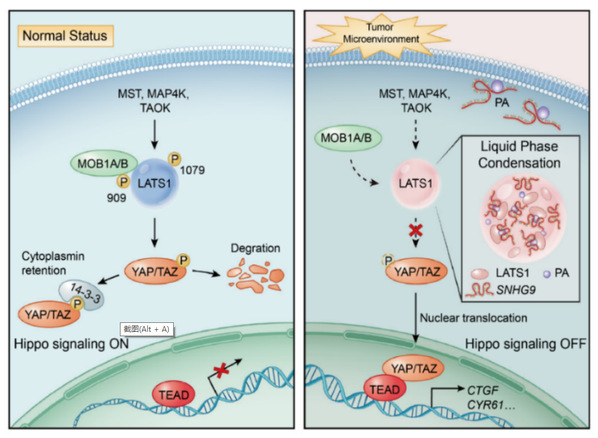Scientists discover role of lncRNA in regulating Hippo signaling via phase separation
Membraneless compartments which are formed via active liquid–liquid phase separation (LLPS) or condensation are crucial for spatiotemporal regulation of cellular functions. LLPS is driven by multivalent, weak interactions, involving intrinsically disordered regions (IDR), folded protein, and scaffolding DNA or RNA molecules. Long noncoding RNAs (lncRNAs) are emerging as a new class of important regulators of signal transduction in tissue homeostasis and cancer development. By coordinating with RNA-binding proteins (RBP), RNAs, such as NEAT1, also play crucial roles in triggering LLPS in a concentration- or structure-dependent manner.
Recent studies demonstrate that lncRNAs play a vital role in mediating intracellular signaling pathways. Previous research by Prof. LIN Aifu from the Zhejiang University College of Life Sciences reveals that LINK-A, a membrane phospholipid PIP3-binding lncRNA, can facilitate AKT–PIP3 interaction and consequent AKT enzymatic activation.
On July 17, Prof. Lin and his team published an open-access article entitled “A Phosphatidic Acid-binding IncRNA SNHG9 Facilitates LATS1 Liquid-liquid Phase Separation to Promote Oncogenic YAP Signaling” in the journal Cell Research.
In this study, researchers identified a lipid-associated lncRNA, small nucleolar RNA host gene 9 (SNHG9) as a tumor-promoting lncRNA driving liquid droplet formation of Large Tumor Suppressor Kinase 1 (LATS1) and inhibiting the Hippo pathway. Mechanistically, SNHG9 and its associated PA bind LATS1 and inhibit LATS1 kinase activity by inducing the LLPS of LATS1. Clinically, SNHG9 expression positively correlates with YAP activation in advanced breast cancers. These findings reveal a cancer-related lncRNA as a crucial regulator of YAP by driving liquid droplet formation of LATS1.
By means of RNA sequencing and bioformatics analysis, researchers discovered a series of over-expressed lncRNAs in breast cancer, among which the expression of SNHG9 increased significantly, suggesting that SNHG9 may well be involved in the malignant progression of breast cancer. As indicated in RNA pull-down assays and lipid dot-blot assays, SNHG9 can directly bind with phosphatidic acid (PA) and LATS1, which can further inhibit the formation of the LATS1-MOB1 complex, diminish LATS activity and YAP phosphorylation and thereby promote the transcription of YAP target genes and proliferation of breast cancer cells.
Researchers detected the subcellular localization of LATS1 using immunofluorescence and found that LATS1 protein was separated into liquid-like droplets, implying that LAST1 may undergo liquid-liquid phase separation in this context. By conducting the bioinformatics analyses of the LATS1 protein sequence, they found that LATS1 is highly disordered and contains a prion-like domain (PrLD) at its N-terminus, which further backs up the hypothesis that LAST1 may undergo liquid-liquid phase separation. To further confirm that PrLD contributes to the phase separation of LATS1, researchers replaced the PrLD of LATS1 with the IDR of FUS protein or IDR of Tia1 protein. Intriguingly, such LATS1 phase separation was still observed, thus proving that PrLD mediated the phase separation of LATS1. A series of further biochemical experiments revealed that SNHG9 can inhibit LATS1-mediated YAP phosphorylation by promoting LATS1 phase separation.

Diagram showing SNHG9 facilitates LATS1 phase separation to regulate the Hippo signaling pathway
Taken together, this research proposed a working pattern where SNHG9 is involved in signal transduction. SNHG9 and its associated PA bind LATS1, precluding the MOB1-LATS1 interaction and LATS1 kinase activity. Moreover, the PrLD of LATS1 gives rise to the LATS1 phase separation. SNHG9 recruits LATS1 aggregation as a scaffold, increases the local concentration of LATS1, promotes LATS1 phase separation and inhibits its kinase activity, thereby promoting YAP entry and transcription activity. This study reveals that SNHG9-LATS1-PA regulates the Hippo signaling pathway and the development of breast cancer via liquid-liquid phase separation, which offers an insightful understanding of the role and mechanism of liquid-liquid phase separation in signal transduction and disease development and provides new targets for the diagnosis and treatment of major human diseases such as cancer.